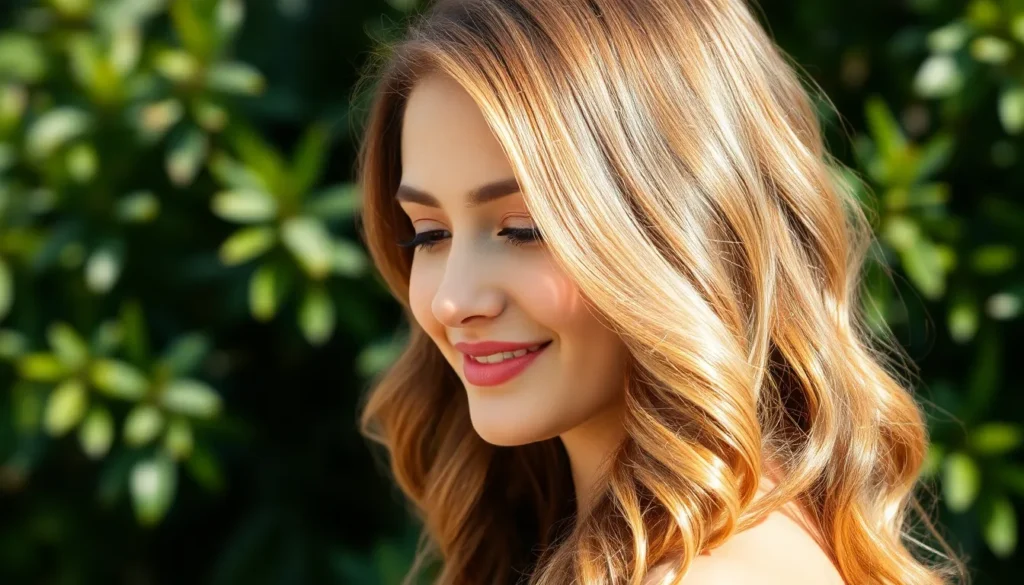Caramel hair color has become one of the most coveted shades in hair fashion and it’s easy to see why. This rich warm tone perfectly bridges the gap between blonde and brunette creating a stunning multidimensional look that flatters virtually every skin tone. From honey-kissed highlights to full caramel transformations we’ve seen celebrities and everyday style enthusiasts embrace this versatile shade.
What makes caramel particularly appealing is its natural-looking depth and the way it catches light throughout the day. Whether you’re looking to add subtle warmth to your existing color or make a bold change caramel offers endless possibilities for customization.
We’ll explore everything you need to know about achieving the perfect caramel hair color including the best techniques maintenance tips and how to choose the right shade for your complexion. Get ready to discover why this trending color might be exactly what your hair routine needs.
What Is Caramel Hair Color and Why It’s So Popular
Caramel hair color captures the essence of melted caramel candy with its rich golden brown base and subtle honey highlights. We define this stunning shade as a warm-toned color that falls between light brown and dark blonde on the spectrum. The color features dimensional layers that create depth and movement throughout the hair.
This luxurious shade mimics the natural tones found in caramelized sugar and golden amber. We see variations ranging from light caramel with peachy undertones to deeper burnt caramel with chocolate lowlights. Each variation maintains the signature warm glow that makes this color so distinctive.
The popularity surge stems from several key factors:
- Universal flattery – Works beautifully on warm, cool, and neutral skin tones
- Low maintenance appeal – Grows out naturally without harsh root lines
- Versatile styling – Complements both casual and formal looks effortlessly
- Celebrity endorsement – Stars like Jennifer Lopez and Blake Lively showcase stunning caramel transformations
- Social media influence – Instagram and TikTok feature thousands of caramel hair transformations daily
Natural sunlight enhances caramel’s multidimensional qualities by revealing hidden golden threads and warm undertones. We notice how this color shifts subtly throughout the day, appearing lighter in bright conditions and richer in softer lighting. The ever-changing nature keeps the look fresh and prevents the flat appearance common with single-process colors.
Caramel works exceptionally well as a transitional shade for those moving between blonde and brunette territories. We recommend this color for clients seeking warmth without the commitment of dramatic change. The shade offers enough contrast to create visual interest while maintaining a natural appearance that suits professional environments.
Determine If Caramel Hair Color Suits Your Skin Tone

We’ll help you discover whether caramel hair color complements your natural complexion by analyzing your skin’s undertones. Matching your skin tone with the right caramel shade ensures a harmonious and flattering result.
Warm Skin Tones
Warm undertones pair beautifully with caramel hair color’s golden base. Golden, yellow, or peachy undertones in your skin create a natural harmony with caramel’s honey highlights and rich amber depths. Check your wrist veins – they’ll appear greenish rather than blue if you have warm undertones.
Rich caramel shades with deeper golden notes complement warm skin perfectly. Burnt caramel variations with copper undertones enhance your natural warmth without competing against your complexion. These deeper caramel tones create stunning contrast while maintaining the color’s signature dimensional appeal.
Avoid cooler caramel variations that contain ashy or beige undertones. These shades can wash out warm skin tones and create an unflattering contrast with your natural coloring.
Cool Skin Tones
Cool undertones require careful caramel shade selection to avoid clashing. Pink, red, or blue undertones in your skin work best with caramel variations that contain neutral or slightly cool elements. Blue veins visible through your wrist skin indicate cool undertones.
Light caramel shades with neutral brown bases suit cool skin tones best. Caramel colors that lean toward taupe or contain subtle ash undertones prevent the warmth from overwhelming your natural coolness. These variations maintain caramel’s appeal while respecting your skin’s natural temperature.
Steer clear of intensely golden or copper heavy caramel shades. These warm variations can create harsh contrast against cool undertones and appear unnatural on your complexion.
Neutral Skin Tones
Neutral undertones offer the most flexibility with caramel hair color choices. Balanced undertones that don’t lean strongly warm or cool allow you to experiment with various caramel depths and intensities. Green and blue veins appear equally visible in neutral skin tones.
Medium caramel shades create perfect balance for neutral complexions. Classic caramel with balanced golden and brown elements complements neutral undertones without pulling too warm or cool. These shades enhance your natural coloring while adding warmth and dimension.
Experiment with seasonal caramel variations to find your perfect match. Lighter caramel works beautifully in spring and summer while deeper burnt caramel enhances your look during fall and winter months.
Choose the Perfect Caramel Hair Color Shade
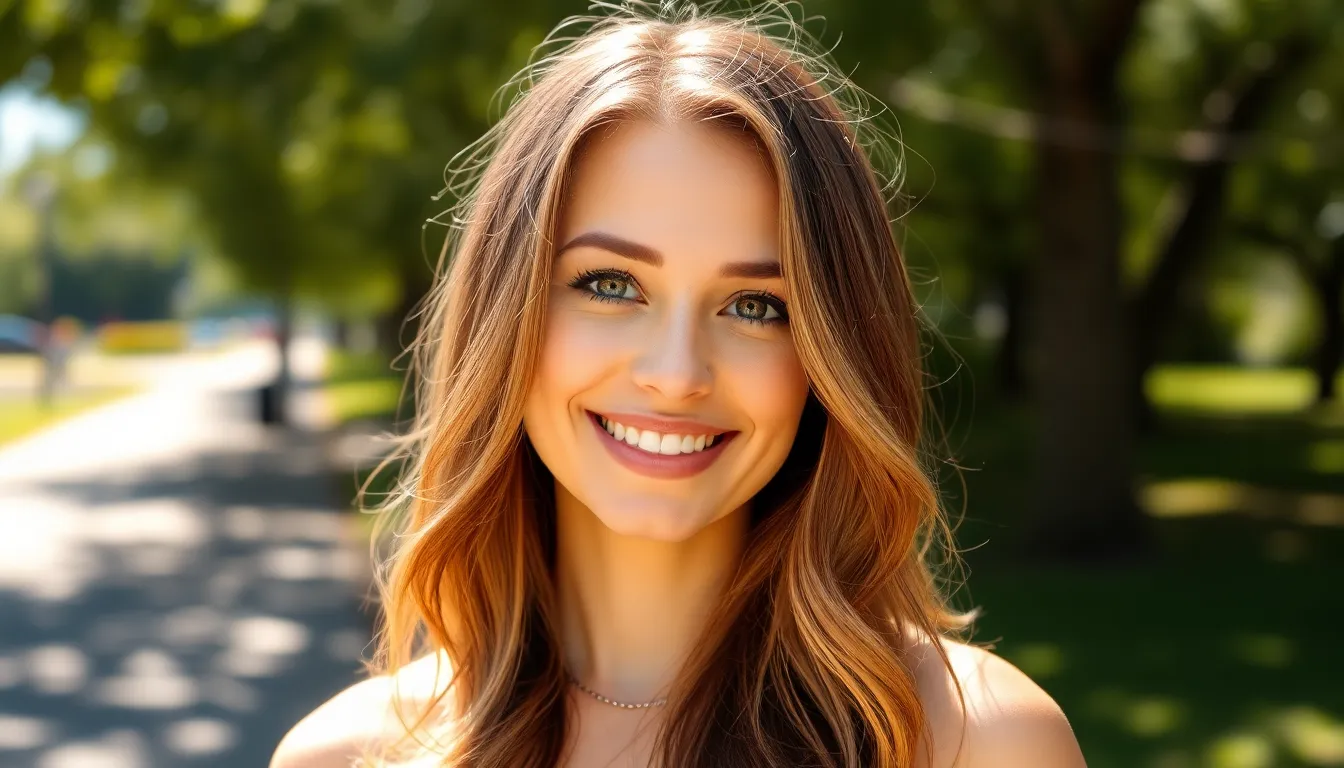
Selecting your ideal caramel shade depends on your natural base color and desired level of contrast. Each caramel variation offers unique benefits that complement different hair textures and maintenance preferences.
Light Caramel Highlights
Light caramel highlights create soft dimension without overwhelming your natural base color. These delicate honey toned streaks work beautifully on medium to dark brown hair, adding subtle warmth and movement. Placement around the face brightens your complexion while maintaining a natural appearance.
Strategic application through the mid lengths and ends prevents harsh regrowth lines. Fine highlights blend seamlessly with your existing color, creating depth that catches light throughout the day. This technique requires minimal maintenance compared to full color transformations.
Professional colorists often recommend light caramel highlights for first time color clients. The gentle contrast allows you to experiment with warmer tones before committing to more dramatic changes.
Medium Caramel Brown
Medium caramel brown delivers the perfect balance between blonde and brunette elements. This versatile shade features rich golden undertones that complement most skin tones while providing noticeable warmth. The depth prevents brassiness while maintaining vibrant color payoff.
Application as an all over color creates stunning results on naturally medium brown hair. Stylists often use this shade as a base before adding lighter caramel accents for extra dimension. The medium tone works exceptionally well for professional environments that require conservative color choices.
Maintenance involves touch ups every 8-10 weeks depending on hair growth and fade patterns. Color depositing treatments help preserve vibrancy between salon visits.
Dark Caramel Tones
Dark caramel tones offer sophisticated depth with subtle warm highlights throughout. These rich shades feature chocolate brown bases enhanced with golden caramel notes that appear in natural light. The darker foundation provides excellent coverage for gray hair while adding youthful warmth.
Brunettes seeking gentle lightening find dark caramel tones perfect for gradual color transitions. The minimal lift required protects hair integrity while delivering noticeable results. Seasonal adjustments allow for deeper tones in winter and slightly lighter variations in summer.
Professional application ensures even color distribution and proper tonal balance. Home maintenance products specifically formulated for warm brunettes help preserve color richness between appointments.
Caramel Balayage Options
Caramel balayage creates natural looking sun kissed effects through hand painted highlighting techniques. This method produces softer grow out patterns compared to traditional foil highlights, making maintenance more manageable. Placement focuses on areas where sun would naturally lighten hair.
Customization options include varying the lightness levels and placement density based on your lifestyle and preferences. Face framing pieces add brightness while subtle body highlights create overall dimension. The technique works on all hair lengths and textures.
Different balayage patterns include subtle ribbons for conservative results or bold contrasts for dramatic transformations. Your colorist can adjust the caramel tones from light honey to deep butterscotch depending on your desired outcome. Processing time varies based on starting color and target shade, typically ranging from 45 minutes to 2 hours.
Prepare Your Hair for Caramel Hair Color Transformation
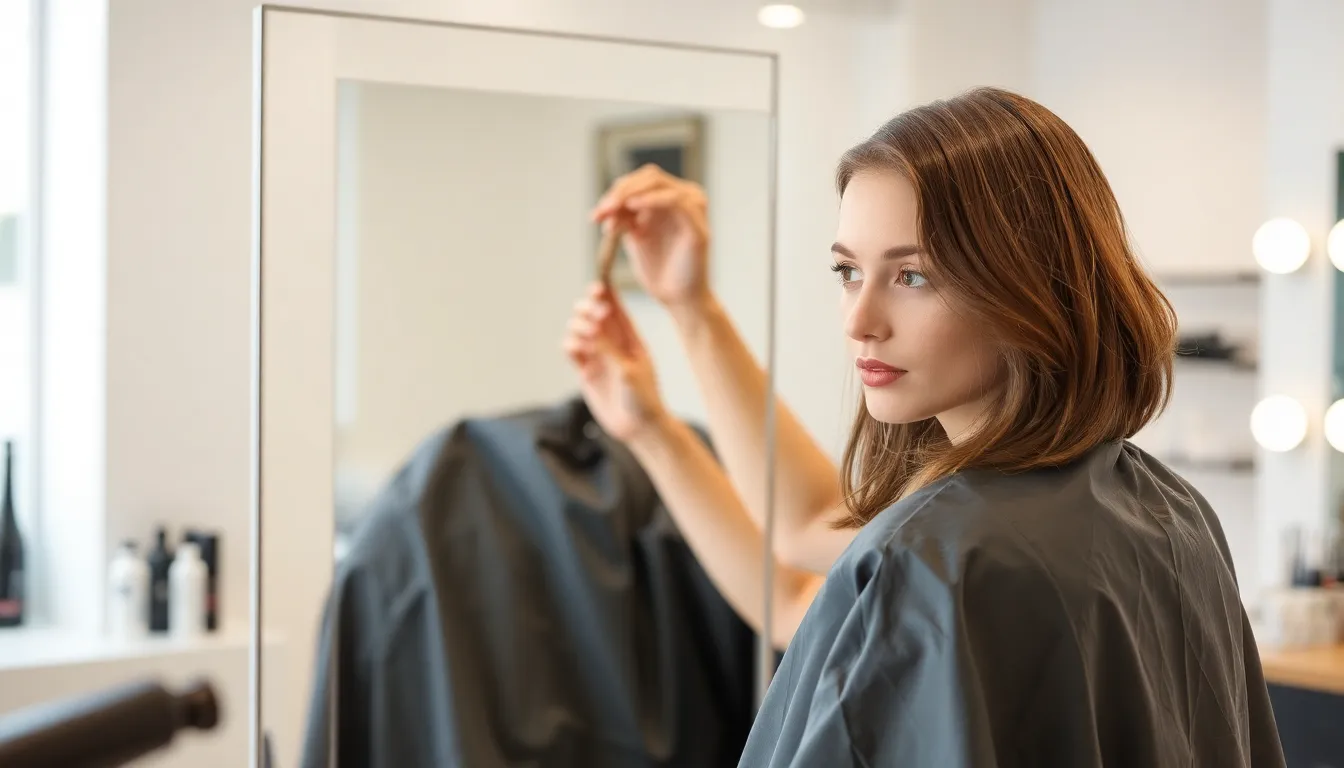
We need to assess your hair’s current condition before diving into caramel transformation. Proper preparation ensures vibrant results and protects your hair’s integrity throughout the coloring process.
Hair Health Assessment
Evaluate strand strength by gently tugging a few wet strands between your fingers. Healthy hair should stretch slightly before snapping back, while damaged hair breaks immediately or feels mushy. We recommend postponing caramel coloring if your hair shows excessive breakage or brittleness.
Check moisture levels using the float test method. Drop clean, dry hair strands into water and observe their behavior. Hair that sinks immediately indicates high porosity and damage, while hair that floats suggests good health and lower porosity levels.
Examine your scalp condition for any irritation, cuts, or sensitivity issues. Active scalp problems require healing time before chemical processing. We suggest waiting at least one week after any scalp treatments or injuries before attempting caramel hair transformation.
Assess previous chemical treatments including relaxers, perms, or recent color applications. Multiple chemical processes can compromise hair integrity and affect caramel color absorption. Document your last coloring service date and products used to help determine processing timing.
Color Removal Requirements
Determine your starting color level using professional color charts or consultation tools. Dark brown to black hair requires more lifting steps to achieve caramel tones than lighter brown bases. We typically need 2-4 levels of lift depending on your desired caramel intensity.
Plan lightening sessions for dramatic color changes from dark to caramel shades. Breaking the process into multiple appointments prevents excessive damage and ensures even color distribution. Most colorists recommend spacing sessions 2-3 weeks apart for optimal hair health.
Consider color correction needs if you have previous box dye buildup or uneven coloring. Professional color removers work more effectively than bleaching for stubborn artificial pigments. We often use gentle clarifying treatments to strip buildup before caramel application.
Test strand compatibility using small hidden sections before full application. Mix your chosen caramel formula on test strands and monitor processing time and results. This preview helps adjust formulation and prevents unwanted color surprises.
Professional vs. At-Home Coloring
Professional colorists offer expertise in complex color formulation and damage prevention techniques. Salon professionals can customize caramel blends specifically for your hair type, condition, and desired outcome. We recommend professional services for dramatic color changes or if you have previously colored hair.
At-home kits provide convenience and cost savings for simple caramel touch-ups or maintenance. Quality drugstore caramel colors work well on virgin hair within 1-2 shades of your natural color. Choose ammonia-free formulas with conditioning agents to minimize damage during processing.
Budget considerations impact your coloring decision timeline and maintenance plan. Professional caramel services typically cost $150-300 but include expert application and aftercare guidance. At-home options range from $8-25 but require careful technique and realistic expectations.
Time investment varies significantly between professional and DIY caramel coloring approaches. Salon appointments take 3-5 hours for complete transformations, while at-home applications require 45-90 minutes plus preparation time. Factor in potential correction costs if at-home attempts require professional fixes.
Apply Caramel Hair Color Like a Pro
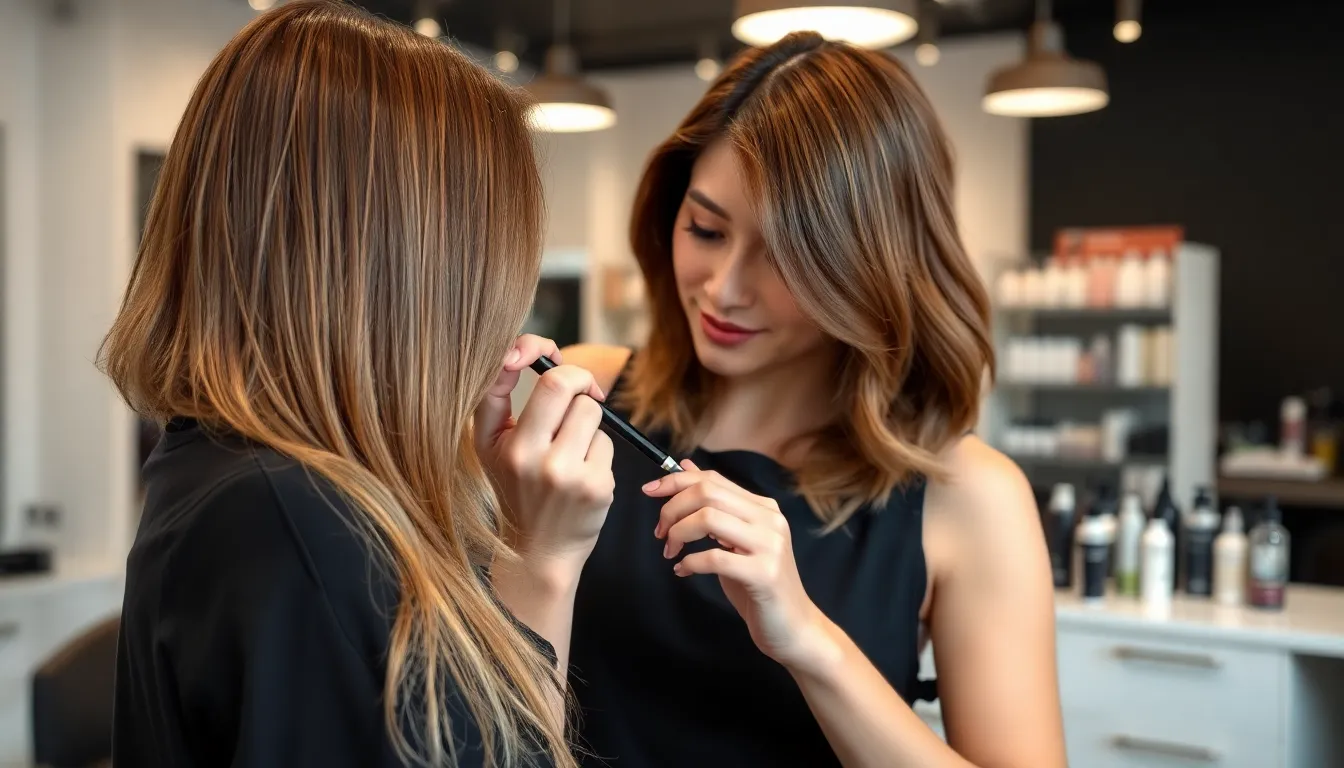
Professional application techniques transform caramel hair color from ordinary to extraordinary, creating the multidimensional warmth that makes this shade so sought after.
Sectioning Techniques
Horizontal sectioning creates the most even caramel color distribution across your entire head. We start at the nape and work upward in 1/4-inch sections, ensuring each layer receives proper coverage. This method prevents patchy results and guarantees consistent color saturation throughout your hair.
Triangle sectioning works best for caramel balayage applications where natural variation is desired. Create small triangular sections throughout the head, alternating the direction of each triangle. This technique mimics natural sun lightening patterns and produces the most organic caramel highlights.
Brick pattern sectioning delivers sophisticated dimension for medium to dark caramel transformations. Offset each row of sections like bricks in a wall, allowing colors to blend seamlessly between layers. Professional colorists prefer this method when transitioning from darker base colors to caramel.
Weaving technique produces subtle caramel highlights that look completely natural. Take thin horizontal sections and weave out every other strand using a tail comb. Apply caramel color only to the woven strands, leaving natural hair between each highlighted piece.
Application Methods
Foil application provides maximum control over caramel color placement and prevents bleeding between sections. Saturate each strand completely before wrapping in foil, ensuring the caramel mixture reaches from root to tip. This method works perfectly for precise caramel highlights and maintains clean separation between treated and natural hair.
Balayage application creates the most natural caramel results by painting color directly onto hair surfaces. Use a flat brush to sweep caramel color in upward motions, concentrating on areas where sun would naturally lighten. Focus on mid lengths and ends while leaving roots darker for dimensional contrast.
Cap highlighting suits those wanting uniform caramel highlights throughout their hair. Pull strands through a perforated cap using a hook tool, then apply caramel color to the pulled sections. This traditional method ensures even spacing and consistent caramel tone across all highlighted areas.
Hand painting technique allows for the most artistic caramel color placement. Apply color with gloved hands to create soft transitions and natural blending. This method works exceptionally well for creating caramel ombre effects and seamless color gradations.
Timing and Processing
Processing time varies based on your starting hair color and desired caramel depth, typically ranging from 20 to 45 minutes. Dark brown hair requires longer processing to achieve light caramel tones, while lighter bases reach caramel shades more quickly. Always perform strand tests to determine optimal timing for your exact hair type.
Heat application can reduce caramel color processing time by up to 50% when used correctly. Cover foiled sections with a plastic cap and apply gentle heat for 10-15 minutes maximum. Monitor color development closely as heat accelerates the lightening process significantly.
Cool processing takes longer but produces gentler caramel results with less potential damage. Allow color to develop at room temperature, checking progress every 10 minutes after the initial 20-minute mark. This method works best for achieving subtle caramel highlights on previously processed hair.
Toner application follows initial caramel processing to perfect the final shade and eliminate unwanted brassiness. Apply toner immediately after rinsing the lightener, processing for 5-20 minutes depending on desired caramel tone. This final step ensures your caramel color matches your vision exactly.
Maintain Your Caramel Hair Color
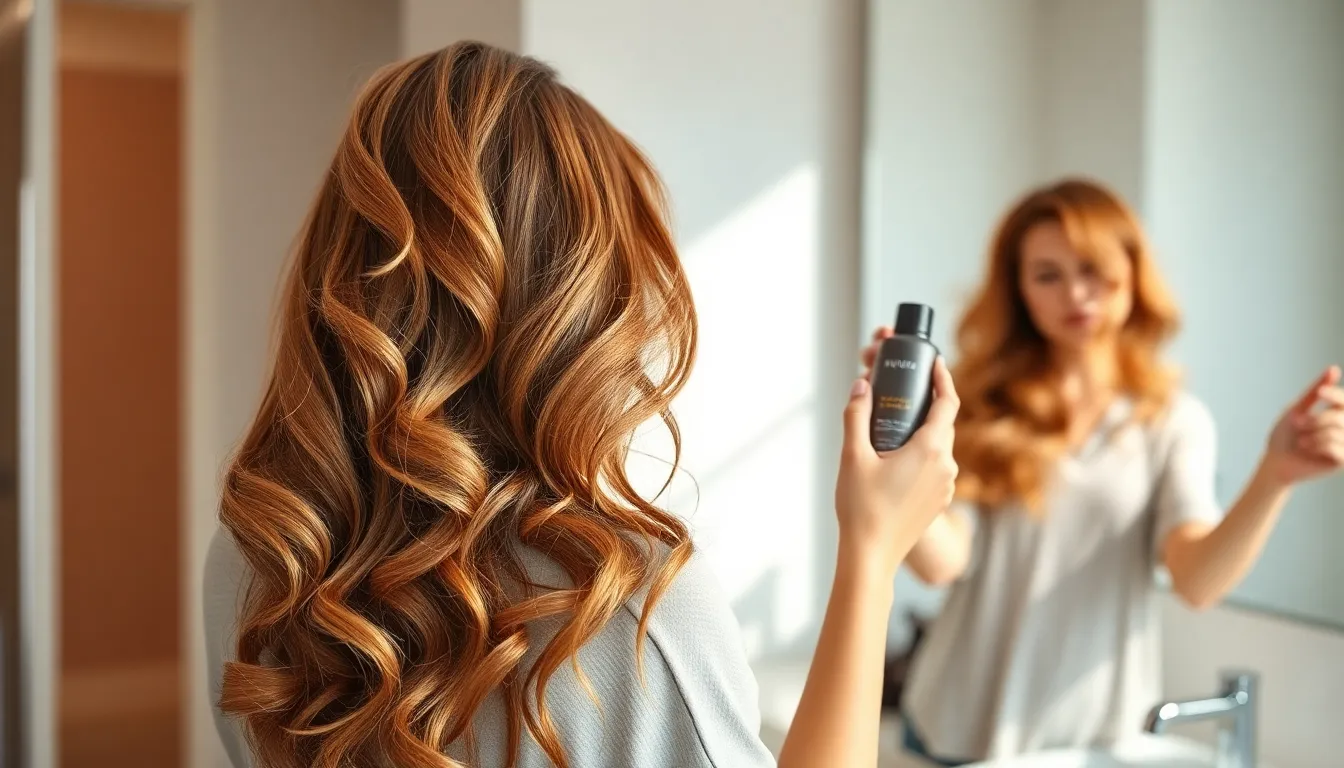
Preserving your stunning caramel hair transformation requires dedicated care and the right maintenance routine. We’ll guide you through essential steps to keep your color vibrant and dimensional for months to come.
Color-Safe Shampoo and Conditioner
Sulfate-free formulas protect your caramel investment from premature fading and harsh chemical stripping. We recommend washing your hair only 2-3 times per week to maintain the color’s integrity and natural oils. Purple-toned shampoos neutralize unwanted brassiness that can develop in lighter caramel highlights over time.
Color-depositing conditioners extend your salon results by adding subtle tints with each use. Look for products specifically formulated for warm brown and golden tones like caramel. Deep conditioning treatments should be applied weekly to maintain moisture levels and prevent dryness that can make your color appear dull.
Professional-grade products deliver superior results compared to drugstore alternatives for color-treated hair. Brands like Redken, Olaplex, and Matrix offer specialized lines for maintaining warm brown shades. We suggest investing in a complete color-safe system including shampoo, conditioner, and leave-in treatments.
Heat Protection Methods
Thermal protectant sprays create an essential barrier between your caramel color and styling tools heated above 300°F. Apply these products to damp hair before blow drying to prevent color molecules from breaking down. Heat damage appears as faded, brassy sections that compromise your caramel’s multidimensional appearance.
Lower temperature settings preserve color vibrancy while still achieving your desired style. We recommend using heat tools at 250-300°F maximum for caramel-colored hair. Higher temperatures can cause the golden and honey tones to shift toward unwanted orange or yellow hues.
Air drying techniques minimize heat exposure and extend your color’s lifespan significantly. Try braiding damp hair for natural waves or using foam rollers for volume without heat damage. When heat styling is necessary, limit sessions to 2-3 times per week maximum.
Touch-Up Schedule
Root touch-ups every 6-8 weeks maintain seamless color blending as your natural hair grows out. We schedule these appointments based on your hair’s growth rate and the contrast between your natural color and caramel shade. Darker natural colors may require more frequent touch-ups to avoid visible regrowth lines.
Gloss treatments every 4-6 weeks refresh your caramel’s shine and enhance the color’s depth between major appointments. These quick services take 20-30 minutes and add vibrancy without the commitment of full color processing. Glosses help maintain the rich golden brown base that defines authentic caramel hair.
Full color refresh appointments occur every 12-16 weeks to address any fading or tonal shifts that develop over time. During these sessions, your colorist can adjust the formula to maintain your ideal caramel shade. We track color changes through photos to ensure consistency with your original transformation goals.
Style Your Caramel Hair Color
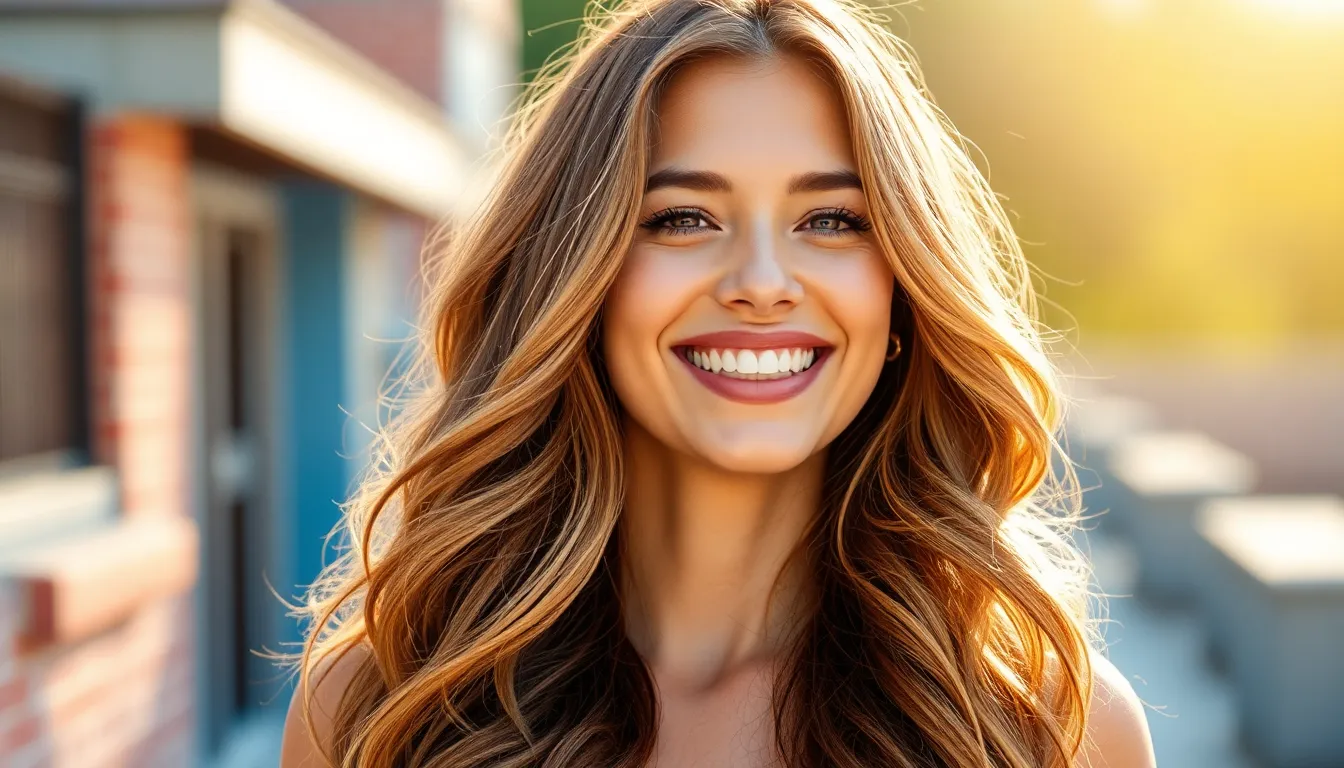
We’ve perfected your caramel transformation, and now it’s time to showcase this stunning shade through strategic styling choices. Proper styling techniques and products can dramatically enhance your caramel hair color’s multidimensional qualities.
Best Cuts for Caramel Tones
Long layered cuts maximize caramel’s dimensional qualities by creating movement that catches light throughout the day. These cuts allow the honey highlights and golden undertones to blend seamlessly while adding volume and texture. Long layers work particularly well with caramel balayage techniques, as each layer showcases different tonal depths.
Beach waves complement caramel tones by creating natural texture that mimics sun kissed hair. The waves catch light at different angles, making the warm golden notes appear more vibrant and ever-changing. This cut pairs beautifully with medium caramel brown shades, creating an effortless, vacation ready appearance.
Face framing layers strategically highlight caramel’s warmth around your complexion. These shorter pieces draw attention to your features while allowing the caramel tones to illuminate your skin tone. Face framing cuts work exceptionally well with light caramel highlights, creating a soft halo effect.
Textured lobs showcase caramel’s versatility while maintaining a polished, professional appearance. The length hits just below the shoulders, providing enough hair to display color variation without overwhelming maintenance. Textured lobs particularly enhance dark caramel tones with their sophisticated depth.
Shag cuts amplify caramel’s natural movement through choppy layers and lived in texture. These cuts create dimension that makes caramel highlights pop against the base color. Shags work well with burnt caramel shades, as the edgy cut balances the color’s sweetness.
Styling Products That Enhance Color
Color protecting shampoos preserve caramel’s vibrancy by preventing fade and maintaining dimensional depth. We recommend sulfate free formulas that cleanse without stripping the warm undertones that make caramel so appealing. Look for products specifically designed for color treated hair to extend your salon results.
Shine improving serums amplify caramel’s natural luminosity by smoothing the hair cuticle and reflecting more light. These products make honey highlights appear more prominent while adding glass like shine to the overall color. Apply serums to damp hair before styling for maximum impact.
Heat protectant sprays safeguard caramel tones from thermal damage while improving color depth during styling. Quality protectants create a barrier that prevents heat from dulling the warm golden notes. Choose products with added shine boosters to maintain caramel’s multidimensional appearance.
Color depositing conditioners refresh caramel tones between salon visits by adding subtle pigments that combat brassiness. These treatments help maintain the perfect balance between golden and brown elements in your caramel shade. Use weekly to keep your color looking freshly done.
Texturizing sprays enhance caramel highlights by creating movement that showcases dimensional layering. These products add grip and volume while maintaining the color’s natural flow. Salt sprays work particularly well for beachy caramel looks, while volumizing sprays suit more polished styles.
Heat Styling Tips
Lower temperature settings protect caramel’s delicate pigments from fading while achieving your desired style. We recommend keeping flat irons below 350°F and curling irons under 300°F to preserve color integrity. Higher temperatures can cause warm undertones to become brassy or fade prematurely.
Sectioning techniques ensure even heat distribution across all caramel toned strands. Work with smaller sections to prevent overheating any area while allowing each piece to showcase its dimensional qualities. This method particularly benefits caramel balayage, as it maintains the natural gradient effect.
Cooling time between passes prevents heat buildup that can damage caramel pigments. Allow each section to cool completely before re styling to maintain color vibrancy. This technique helps preserve the honey highlights and golden undertones that define beautiful caramel hair.
Alternating curl directions create natural movement that enhances caramel’s multidimensional appearance. Curl some sections away from your face and others toward it to achieve effortless looking texture. This technique makes light catching qualities more prominent throughout your hair.
Finishing with cool air seals the hair cuticle and locks in caramel’s shine after heat styling. Use your blow dryer’s cool setting for 30 seconds on each styled section. Cool air helps maintain the smooth, reflective surface that makes caramel tones appear more vibrant and healthy.
Avoid Common Caramel Hair Color Mistakes
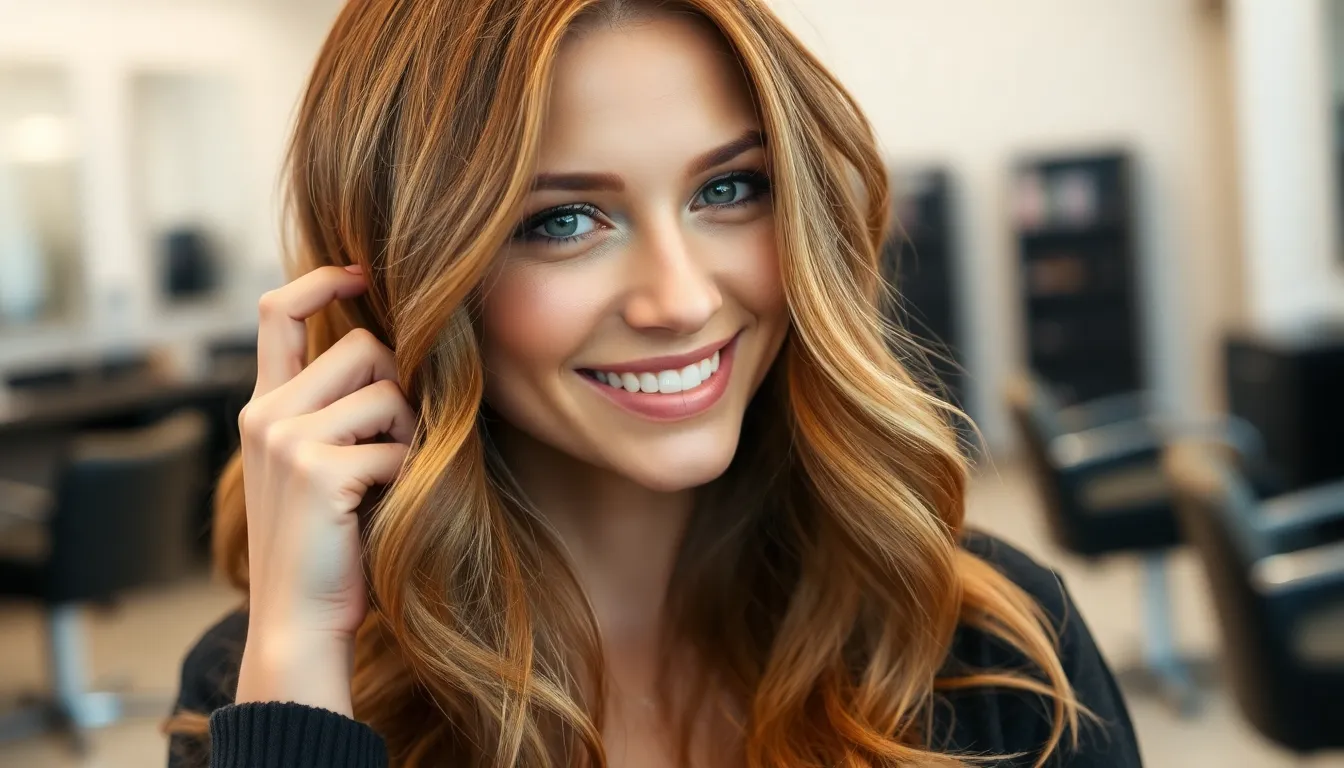
Achieving the perfect caramel hair color requires careful attention to detail and proper technique. We’ve identified the most frequent mistakes that can turn your caramel dream into a color nightmare.
Over-Processing Errors
Bleaching hair too aggressively creates irreversible damage that prevents caramel tones from adhering properly to the hair shaft. We recommend lightening hair gradually over multiple sessions rather than attempting dramatic changes in one appointment. Processing virgin hair requires 20-30 minutes with 20-volume developer, while previously colored hair needs gentler 10-volume developer for 15-20 minutes.
Ignoring strand tests leads to unpredictable color results and potential hair breakage during the caramel transformation process. We always test a small hidden section 48 hours before full application to assess how your hair responds to the chemicals. Different hair textures absorb color differently, with fine hair processing faster than coarse hair by approximately 25%.
Overlapping chemical treatments weakens hair structure and creates uneven caramel color distribution throughout your strands. We suggest waiting 2-3 weeks between chemical services like relaxers, perms, or previous color treatments before applying caramel shades. Fresh chemical treatments can interfere with color molecules and create muddy or brassy results.
Rushing the development time prevents caramel pigments from fully penetrating the hair cuticle, resulting in faded color within days. We monitor processing every 10 minutes during application, checking for even color development and proper tone saturation. Most caramel applications require 35-45 minutes for optimal results, depending on your starting base color.
Color Matching Issues
Choosing the wrong undertone for your skin creates a caramel shade that clashes with your natural coloring instead of improving it. We analyze your skin’s undertones before selecting caramel variations, matching warm golden caramels to warm skin and neutral caramels to cool complexions. Cool-toned individuals should avoid orange-based caramels that can appear harsh against their natural coloring.
Mismatching your natural base color results in caramel shades that look artificial or overly contrasted against your roots. We evaluate your current hair color and select caramel tones within 2-3 levels of your natural shade for seamless blending. Dark brown hair requires deeper caramel browns, while medium brown hair suits lighter caramel highlights for natural dimension.
Ignoring seasonal color variations can make your caramel hair appear out of harmony with your overall appearance throughout the year. We recommend adjusting caramel intensity based on seasonal changes, choosing richer caramels for fall and winter, lighter caramels for spring and summer. Your skin tone may shift slightly with sun exposure, requiring subtle caramel adjustments every 6 months.
Copying celebrity caramel colors without considering your unique features often leads to disappointment and unflattering results. We customize caramel formulations based on your eye color, skin tone, and personal style rather than replicating exact celebrity looks. What works for someone with different coloring may not complement your natural features.
Maintenance Neglect
Using regular drugstore shampoo strips caramel color molecules from your hair, causing rapid fading and brassiness within 2-3 weeks. We recommend sulfate-free, color-safe shampoos specifically formulated for colored hair to preserve caramel vibrancy. Purple-toned shampoos neutralize unwanted orange tones that can develop in caramel hair over time.
Skipping heat protection allows styling tools to damage caramel-colored hair and accelerate color fading with each use. We apply thermal protectant sprays before using blow dryers, flat irons, or curling tools to create a barrier against heat damage. High temperatures above 350°F can cause caramel pigments to break down and fade prematurely.
Inconsistent touch-up scheduling creates visible root growth and uneven color distribution that detracts from your caramel transformation. We establish a maintenance timeline with root touch-ups every 6-8 weeks and gloss treatments every 4-6 weeks to maintain color freshness. Waiting too long between appointments can make color correction more difficult and expensive.
Neglecting deep conditioning treatments leaves caramel-colored hair dry, brittle, and prone to breakage that affects overall color appearance. We incorporate weekly deep conditioning masks with color-safe ingredients to maintain hair health and color vibrancy. Moisturized hair holds caramel color longer and reflects light better for enhanced shine and dimension.
Transition from Caramel Hair Color
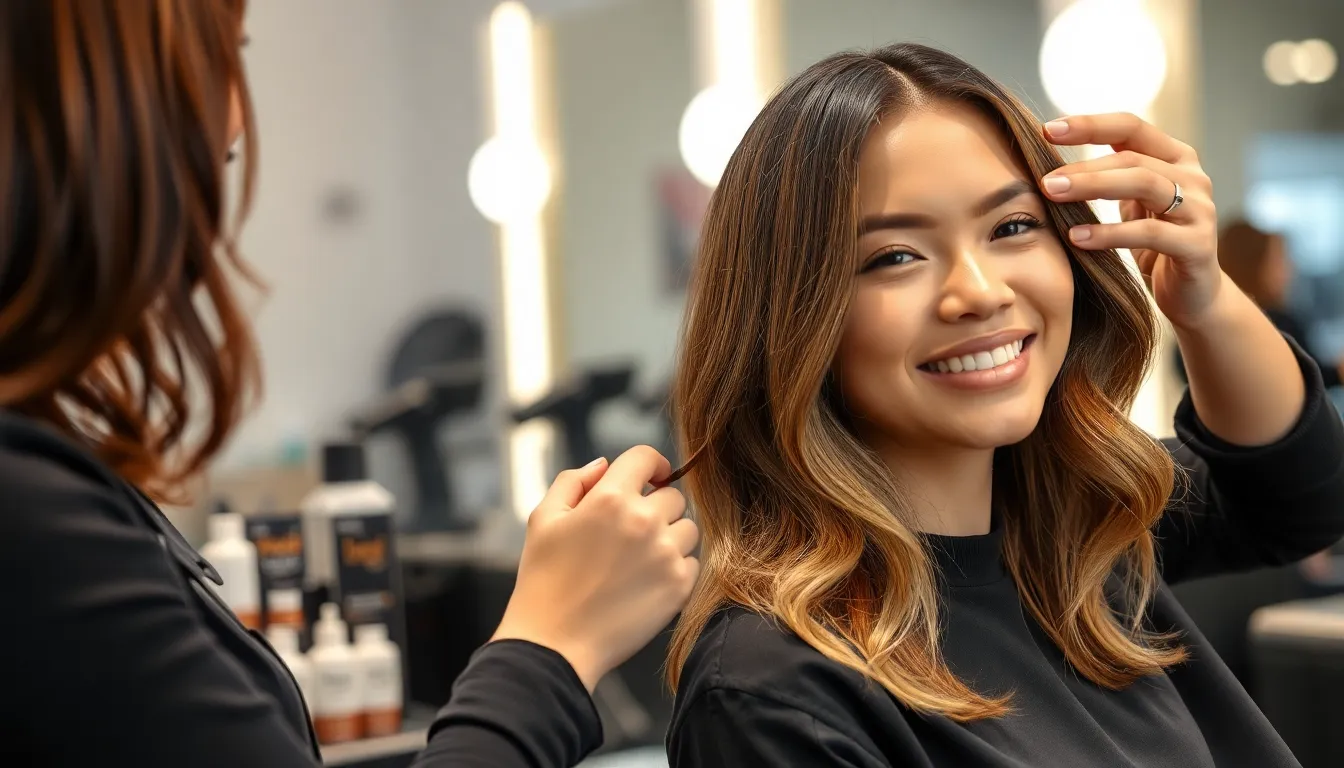
Sometimes we need to move beyond our beloved caramel tones for fresh styling opportunities or seasonal changes.
Growing Out Gracefully
Strategic techniques help maintain style during caramel color transitions without compromising hair health. We recommend scheduling appointments every 8-10 weeks for root blending services that gradually lighten darker regrowth areas. Balayage touch-ups create seamless transitions by painting lighter sections throughout mid-lengths and ends.
Dimensional lowlights add depth while camouflaging obvious color lines between processed and natural hair. We suggest incorporating subtle highlights around the face to brighten overall appearance during growth phases. Root shadowing techniques blend harsh demarcation lines by applying darker tones near the scalp.
Professional colorists can extend transition periods by using temporary root concealers between appointments. Color-depositing shampoos maintain vibrancy in existing caramel sections while new growth develops naturally. Heat-free styling methods prevent additional damage during vulnerable transition phases.
Color Correction Options
Professional color correction transforms unwanted caramel results into desired shades through targeted treatments. We evaluate underlying pigments before selecting appropriate removal methods such as color stripping or lightening processes. Gentle bleach applications lift stubborn caramel tones while preserving hair integrity through careful monitoring.
Toner applications neutralize brassy undertones that appear during correction procedures. We recommend protein treatments between correction sessions to strengthen compromised hair cuticles. Color-filling techniques restore missing pigments before applying final desired shades.
Multiple appointment schedules allow gradual corrections that minimize damage risks. Professional products contain specialized ingredients that protect hair during intensive color removal processes. Strand testing determines optimal processing times for each individual’s unique hair characteristics.
Next Color Choices
Natural brunette shades provide effortless transitions from caramel tones through strategic lowlight placement. We suggest rich chocolate browns that complement existing warm undertones while adding sophisticated depth. Espresso tones create dramatic contrasts when applied as all-over color or dimensional highlights.
Blonde transformations require careful lightening processes to achieve desired caramel-to-blonde transitions. Golden blonde shades maintain warmth while moving toward lighter territories. Platinum goals need professional expertise due to extensive processing requirements.
Bold fashion colors offer creative alternatives for adventurous clients seeking dramatic changes. We recommend auburn reds that blend naturally with caramel base colors through strategic placement techniques. Rose gold applications create trendy looks while maintaining some familiar warmth. Copper tones enhance natural dimensional qualities already present in caramel hair.
Conclusion
We’ve explored the captivating industry of caramel hair color and discovered why it’s become such a beloved choice among beauty enthusiasts. This warm multidimensional shade offers endless possibilities for customization while remaining universally flattering.
Whether you’re considering your first caramel transformation or planning your next color journey caramel provides the perfect balance of sophistication and warmth. The key lies in choosing the right shade for your unique features and committing to proper maintenance routines.
With professional guidance and the right care techniques your caramel hair color can remain vibrant and stunning for months to come. We encourage you to embrace this beautiful shade and enjoy the confidence that comes with perfectly executed caramel tones.
Frequently Asked Questions
What is caramel hair color?
Caramel hair color is a rich, warm tone that seamlessly blends blonde and brunette shades. It features a golden brown base with subtle honey highlights and dimensional layers, capturing the essence of melted caramel candy. This multidimensional color adds depth and movement to hair while creating natural-looking warmth.
Who does caramel hair color suit best?
Caramel hair color is universally flattering across different skin tones. Warm skin tones pair well with rich caramel shades featuring deeper golden notes, while cool skin tones suit light caramel with neutral elements. Those with neutral skin tones have the most flexibility to experiment with various caramel depths.
How long does caramel hair color last?
Caramel hair color typically lasts 6-8 weeks before requiring root touch-ups. The overall color may begin to fade after 8-12 weeks. With proper maintenance using color-safe products and regular gloss treatments every 4-6 weeks, you can extend the vibrancy and keep your caramel shade looking fresh.
Is caramel hair color high maintenance?
Caramel hair color is considered relatively low maintenance compared to other fashion colors. It requires root touch-ups every 6-8 weeks, regular use of color-safe shampoos, and occasional gloss treatments. The natural dimension of caramel helps disguise regrowth, making it easier to maintain between salon visits.
Can I achieve caramel hair color at home?
While at-home caramel coloring is possible with box dyes, professional application is recommended for best results. Complex transformations, especially from darker colors, require professional expertise to achieve even color distribution and prevent damage. At-home kits work better for simple touch-ups or subtle changes.
What’s the difference between caramel and honey hair color?
Caramel hair color features deeper golden brown tones with rich, warm undertones, while honey hair color is typically lighter with more yellow-based highlights. Caramel offers more dimension with deeper lowlights, whereas honey tends to be brighter and more uniform in tone throughout the hair.
How do I maintain caramel hair color?
Maintain caramel hair by using sulfate-free, color-safe shampoos and washing only 2-3 times weekly. Use purple-toned shampoos to combat brassiness, apply heat protectant before styling, and schedule regular gloss treatments. Deep conditioning treatments help preserve moisture and color vibrancy between salon visits.
What hair cuts work best with caramel color?
Long layers, beach waves, textured lobs, and face-framing cuts showcase caramel’s dimensional qualities beautifully. Shag cuts and layered styles allow light to catch different tones throughout the hair. These cuts emphasize movement and highlight the multidimensional nature of caramel coloring.
Can caramel hair color cover gray hair?
Yes, caramel hair color can effectively cover gray hair, especially darker caramel tones. The rich pigments provide excellent coverage while adding warmth and dimension. However, extensive gray coverage may require professional application to ensure even color distribution and proper processing time.
How much does caramel hair color cost?
Professional caramel hair coloring typically ranges from $150-$400 depending on hair length, complexity, and salon location. Full transformations cost more than simple highlights. At-home kits range from $10-$30 but may require multiple applications. Maintenance appointments every 6-8 weeks add to the ongoing cost.

